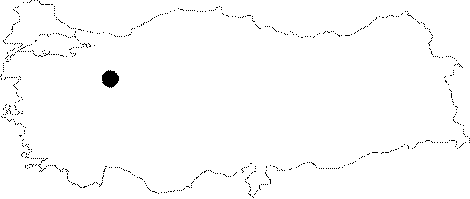|
©The Archaeological Settlements of Turkey - TAY Project
|
|
|
|
|
|
Findik Kayabasi |
|
|
For site maps and drawings please click on the picture...  |
For photographs please click on the photo...  |
|
Type:
|
Flat Settlement |
|
Altitude:
|
940 m |
|
Region:
|
Aegean |
|
Province:
|
Kütahya |
|
District:
|
Merkez |
|
Village:
|
Findikköy |
|
Investigation Method:
|
Survey |
|
Period:
|
Ceramic |
|
|
|
 |
|
| Location: This site lies northeast of the city of Kütahya; approximately 3 km northeast of the village of Sabuncular-Findik; at the border of the provinces of Kütahya and Eskisehir. The site lies 500 m south of the Eskisehir-Kütahya railroad tracks. |
| Geography and Environment: The site lies on the northern side of a rocky outcrop. Efe believes that this slope; now very steep; was previously terraced [Efe 1995b:106]. The rocky areas rise steeply out of two sides of the cliff. The eastern rocks have rooms; probably Byzantine in date; carved into them. The site lies south of Findik Stream or Asi Stream which is a tributary of Kargin Stream. |
| History: |
| Research and Excavation: The steep rock-outcrop-site; discovered by C.H.E. Haspels; was visited by T. Efe during his 1988 survey of the Kütahya; Eskisehir and Bilecik Provinces [Efe 1990:409; fig.16]. It takes place in the registered archaeological sites list prepared by Ministry of Culture and Tourism. |
| Stratigraphy: In addition to Neolithic finds; a couple of Early Bronze Age sherds and other wheel-made ceramic fragments suggest that the site was used as a temporary habitation area in later periods. |
| Small Finds: Pottery: The sherds assigned to the Neolithic by Efe are described as having grit temper and being gray and grayish-brown in color. The surfaces are rarely slipped (and if they are; usually with red slip) and have instead been well smoothed and burnished. The ware is well fired. The most common Neolithic forms are "S" shaped; thick-lipped; round-bodied deep bowls and jars [Efe 1995b:fig.1-6; 8]. Shallow bowls are very rare. All forms have flat bottoms. Pierced lugs are difficult to find. One box-shaped vessel with groove decoration resembles Fikirtepe finds [Efe 1995b:fig.2/12]. In addition; brown clay ware with thick; cream-colored slip and a red painted band and decorated with diagonally placed parallel lines was found. Chipped Stone: Most of the chipped stone tools found on the surface are of flint; although one obsidian blade was found. The industry can be classified as a flake industry. Some of the chipped stone tools resemble microliths [Efe 1995b:1-6]. |
| Remains: |
| Interpretation and Dating: Efe assigns this site to the Neolithic by comparing the finds with those from other sites. Because the ceramic ware and forms are simpler than Fikirtepe pottery; and because this site lacks pierced lugs; Efe suggests that the site should be assigned to the earliest Ceramic Neolithic Period; before Fikirtepe [Efe 1995b:109]. The box-shaped vessel with grooved decoration and the slipped; red painted ware show close affinity with finds from Ilipinar X. |